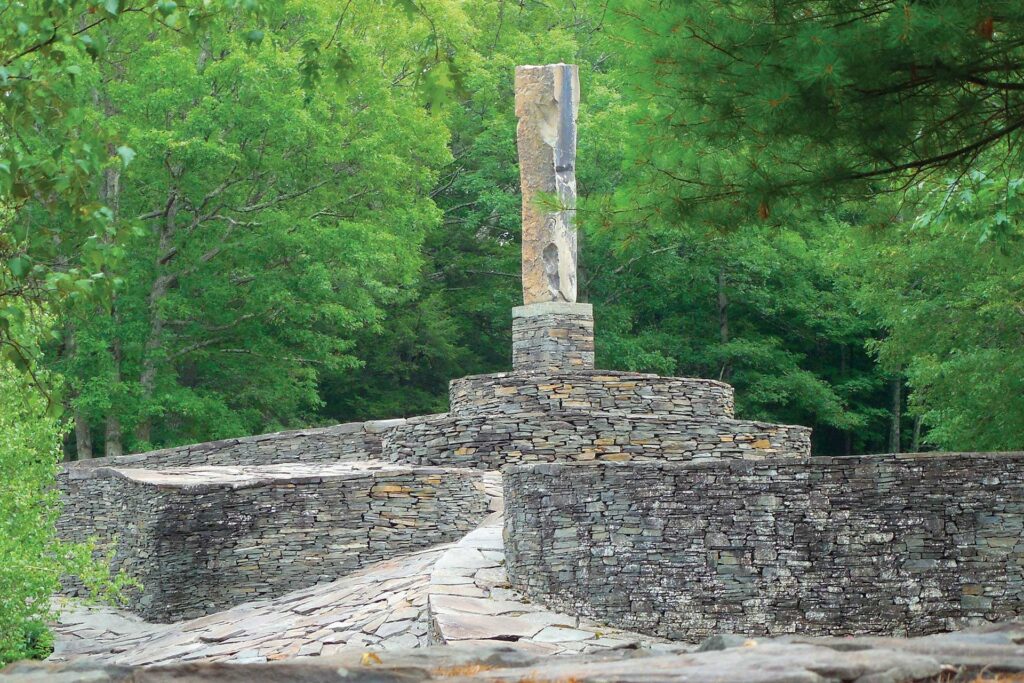Saugerties’ sculpture park is home to artist Harvey Fite’s stunning outdoor art—and live music. BYOB.
By Sarah Carpenter
The last thing I want to do after I’ve been driving for a couple hours is step indoors and crowd around a table. The perfect road trip break is one that frees the knees, I say. Maybe I’m just getting old.
Just off the Glasco Turnpike in Saugerties, NY near the Hudson River is a road tripper’s dream stop: Opus 40. About an hour is plenty of time to take in this outdoor work of art. Grab some food to-go from one of many nearby restaurants and pop outside for a sprawling open-air respite from that seated position. There’s plenty of picnic space, complete with chairs and tables if you want (I opt for a picnic blanket) and your legs will appreciate the wandering you’re wont to do amongst the hand-crafted maze of stone.
There’s one impossible fact about the gorgeous six-acre stonework park that’ll replay in your head as you take in the pathways, the sculptures, the nooks and crannies: It’s all the work of one man. Stone by stone, self-taught sculptor Harvey Fite masoned his personal masterpiece in the bluestone quarry over the course of 37 years, channeling Mayan stone building techniques he observed while working in Copán, Honduras. The dry key construction doesn’t require mortar or cement—it’s all flat stone strategically placed. Done correctly, and with proper maintenance, it could last millennia.
Fite initially used the site as a gallery for his humanist sculptures. The iconic monolith that punctuates the landscape was a piece of stone that he intended to sculpt. He’d spotted the piece on a bit of neighboring property, and the owners of the land it was on wanted a fee he couldn’t pay. A decade later, Fite finally acquired the stone, and set the monolith into place using ancient Egyptian techniques for raising obelisks. His intention was to carve the stone, but after placing it, he looked around at what he’d created and decided it was so much greater than a place for sculptures—the setting was a work of art in and of itself.
Inspired by classical music, he named it Opus 40 for the four decades he expected it to take to finish—and music would become a major part of the site’s legacy.
In 1966, Fite had begun work on an amphitheater he wouldn’t finish before his his death in 1976. It was completed in 1980, turning the sculpture park into a venue that continues to host concerts today. Check if there’ll be a concert before you go and buy tickets online. Am I saying you could theoretically get out from behind the wheel, frolic through an immersive bluestone landscape, fill your tummy and listen to a live concerto? That’ll be a yes—but do frolic with care because there are several spots that could trip you up.
Children will require supervision, but there’s lot for them to do here: the “Be a Sculptor” section’s the only place you’re allowed to pick up the rocks, and kids (grownups too) are encouraged to make their own earthwork sculptures in this zone.
Opus 40 recently acquired the house built by Fite adjacent to the sculpture park. It’s undergoing careful restorations to bring the building up to code, but it’s expected to bring new programs in partnership with Bard College to explore Fite’s impressive legacy and the history around his work.
Get in your car, find a nostalgic station and drive processing the majestic ode to the human will to create what you just experienced.
Opus 40 is open every Thursday to Monday through October from 10:30am to 5pm. $11/adult

Comments are closed.